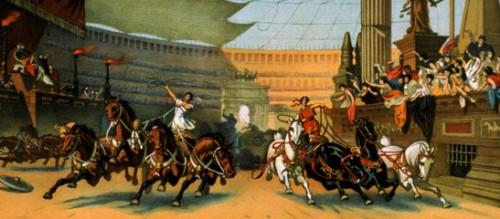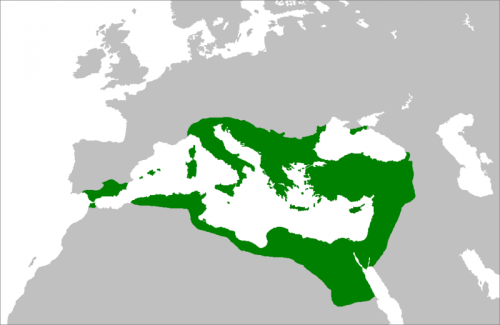
A Roman chariot race, showing men from two of the four color-themed demes, or associations, that produced the Blues and the Greens. From a poster advertising the 1925 film version of Ben-Hur. Image: Wikicommons.
“Bread and circuses,” the poet Juvenal wrote scathingly. “That’s all the common people want.” Food and entertainment. Or to put it another way, basic sustenance and bloodshed, because the most popular entertainments offered by the circuses of Rome were the gladiators and chariot racing, the latter often as deadly as the former. As many as 12 four-horse teams raced one another seven times around the confines of the greatest arenas—the Circus Maximus in Rome was 2,000 feet long, but its track was not more than 150 feet wide—and rules were few, collisions all but inevitable, and hideous injuries to the charioteers extremely commonplace. Ancient inscriptions frequently record the deaths of famous racers in their early 20s, crushed against the stone spina that ran down the center of the race track or dragged behind their horses after their chariots were smashed.
Charioteers, who generally started out as slaves, took these risks because there were fortunes to be won. Successful racers who survived could grow enormously wealthy—another Roman poet,Martial, grumbled in the first century A.D. that it was possible to make as much as 15 bags of gold for winning a single race. Diocles, the most successful charioteer of them all, earned an estimated 36 million sesterces in the course of his glittering career, a sum sufficient to feed the whole city of Rome for a year. Spectators, too, wagered and won substantial sums, enough for the races to be plagued by all manner of dirty tricks; there is evidence that the fans sometimes hurled nail-studded curse tablets onto the track in an attempt to disable their rivals.
In the days of the Roman republic, the races featured four color-themed teams, the Reds, the Whites, the Greens and the Blues, each of which attracted fanatical support. By the sixth century A.D., after the western half of the empire fell, only two of these survived—the Greens had incorporated the Reds, and the Whites had been absorbed into the Blues. But the two remaining teams were wildly popular in the Eastern, or Byzantine, Empire, which had its capital at Constantinople, and their supporters were as passionate as ever—so much so that they were frequently responsible for bloody riots.

The Byzantine Empire at its height under the Emperor Justinian in c. 560. Map: Wikicommons.
Exactly what the Blues and the Greens stood for remains a matter of dispute among historians. For a long time it was thought that the two groups gradually evolved into what were essentially early political parties, the Blues representing the ruling classes and standing for religious orthodoxy, and the Greens being the party of the people. The Greens were also depicted as proponents of the highly divisive theology of Monophysitism, an influential heresy which held that Christ was not simultaneously divine and human but had only a single nature. (In the fifth and sixth centuries A.D., it threatened to tear the Byzantine Empire apart.) These views were vigorously challenged in the 1970s by Alan Cameron, not least on the grounds that the games were more important than politics in this period, and perfectly capable of arousing violent passions on their own. In 501, for example, the Greens ambushed the Blues in Constantinople’s amphitheater and massacred 3,000 of them. Four years later, in Antioch, there was a riot caused by the triumph of Porphyrius, a Green charioteer who had defected from the Blues.
Even Cameron concedes that this suggests that after about 500 the rivalry between the Greens and the Blues escalated and spread well outside Constantinople’s chariot racing track, the Hippodrome–a slightly smaller version of the Circus Maximus whose central importance to the capital is illustrated by its position directly adjacent to the main imperial palace. (Byzantine emperors had their own entrance to the arena, a passageway that led directly from the palace to their private box.) This friction came to a head during the reign of Justinian (c. 482-565), one of Byzantium’s greatest but most controversial emperors.

The ruins of Constantinople's Hippodrome in 1600, from an engraving by Onofrio Panvinio in De Ludis Circensibus. The spina that stood at the center of the chariot racing circuit was still visible then; in modern Istanbul, only three of the ancient monuments remain.
PART. 2